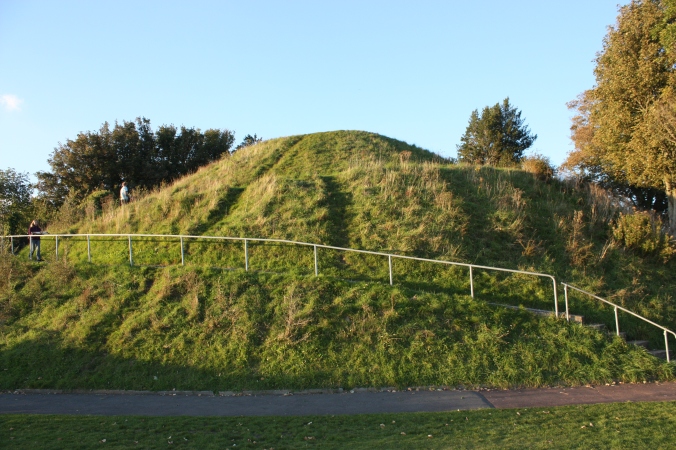The full title of our research project is Extending Histories: from medieval mottes to prehistoric round mounds, and that is exactly what our work is doing: we are extending our knowledge of these enigmatic mounds, challenging assumptions, and finding that the histories of these monuments aren’t always as straightforward as we think they are.
Our investigations in East Sussex, down on the south coast, have produced some intriguing results…
As we will discuss in a forthcoming post, the radiocarbon dates from the first set of study sites are in. As well as finding a prehistoric mound, of an unprecedented scale for its date, in East Yorkshire, our investigations down on the South Coast have also produced some intriguing results.
A town of many mounds
The town of Lewes, East Sussex, with a population of just over 17,000 people, is particularly well-endowed when it comes to mounds. Up on the high ground overlooking the town is Lewes Castle, a Norman motte and bailey type castle with later additions, which is unique in that it has two mottes (castle mounds), and if that wasn’t enough, down the hill and next to the present-day site of Lewes FC’s football ground (“The Dripping Pan“), Lewes has a third, perhaps even more enigmatic mound: known either as “The Calvary” or simply “The Mount”.

The Mount, aka The Calvary, complete with a spiral pathway to the summit.
Given that the castle at Lewes, much of which is still standing today, already has two mounds, the origin and purpose of this third feature, The Mount, has been rather obscure. The Mount sits within the grounds of the former Priory of St Pancras, and its alternative name, The Calvary, illustrates the strong religious connotations of the site which is also reflected in the local tradition of erecting a crucifix on the summit at Easter. A variety of explanations have been put forward for the origins of The Mount: a religious symbol built by the monks of the Priory of St Pancras; a spoil heap, a by-product of salt production; the site of an earlier fortification; or perhaps even a garden feature-cum-viewing platform?
Getting to the bottom of it
Establishing the date of construction of The Mount could be crucial to unpicking this conundrum – which is where the Round Mounds Project comes in…

Coring The Mount, Lewes, in the autumn sun.
The Mount, which is up to 13m high, and is constructed from large fragments of chalk and flint bound together with clay (all derived from the local geology), was cored in Autumn 2015. The team drilled two boreholes: one from the summit, and a second down-slope a little. In the laboratory a large number of charcoal fragments were extracted, and these fragments were submitted for radiocarbon dating. The results showed that charcoal from a range of sources had been incorporated into the mound during its construction, but the dates were clear: The Mount was constructed at some point after the mid-15th to early 16th century. This means that The Mount was either built right at the end of the life of the Priory, or perhaps more likely, after the Dissolution when the site became part of the gardens of a substantial house, known as Lords Place. As such, it seems most probable, that this mound is indeed a garden feature.
A grand garden feature – a Prospect Mound
Radiocarbon dating has shown The Mound, Lewes, dates to some time after the mid-15th to early 16th century AD.
The Mount is certainly not the only garden mound, often called a Prospect Mound, that the team have investigated. Many mounds, regardless of their original construction date, have since been converted into rather grand garden ornaments: Marlborough Mound, for example, which was originally constructed in the Neolithic period, and was re-used by the Normans as a castle motte, was finally re-cycled into a Prospect Mound, complete with grotto and spiral pathway. All this just goes to show how complex the history of these large earthwork monuments can be!

William Stukeley’s drawing of the Marlborough Mound, Wiltshire, shown here in its guise as a prospect mound complete with spiral pathway, grotto, and neo-classical folly, set within a formal garden.
Pingback: The Round Mounds Project on tour: talks and conference presentations | The Round Mounds Project
My husband and I used to live at No 1 Priory Street in Lewes, East Sussex. This property is the first house in a terraced row which runs along from the railway bridge at the roundabout with Mountfield Road and Station Street up towards Priory Crescent, on the south side of the town. The back garden is a small triangle which backs onto the railway cutting for the line to Falmer and Brighton, so our bathroom and the back bedroom looked out over the railway cutting over to the lovely two copper beech trees on the Mount. When we had the external paintwork on the house stripped and repainted, around 2010 I think, we found that the house had a name, above the front door: Prospect Cottage. Perhaps this lends weight to the idea that it may have been a garden mound at some point..?
LikeLike
If you haven’t already,it may be worth looking into the mound which forms the island in Mount Pond on Clapham Common in South London….definitely a “Prospect Mound” and possibly of much earlier origin.
LikeLike